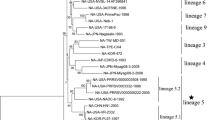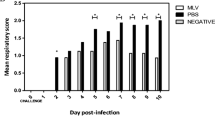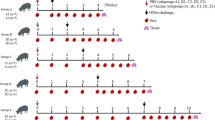Abstract
A novel PRRSV strain was isolated in China that was genetically similar to the NADC30 strain which is reported to have spread throughout China. The objective of the present study was to evaluate the cross-protective efficacy of the live vaccine TJM-F92 in young pigs against challenge with a NADC30-like strain, HN201605. Twenty-five PRRSV- and antibody-free pigs were randomly divided into the following five groups: Vac/ChA, Unvac/ChA, Vac/ChB, Unvac/ChB and the mock. The pigs in groups Vac/ChA and Vac/ChB were inoculated intramuscularly with 1 mL TJM-F92 (105.0 TCID50/mL). At 28 days post vaccination (0 days post challenge), groups Vac/ChA and Unvac/ChA were inoculated intranasally with 104.5 TCID50/mL PRRSV strain TJ F3 (2 mL/pig), while groups Vac/ChB and Unvac/ChB were inoculated, using the same route, with the same dose of the NADC30-like strain HN201605 F3. Protective effects of the PRRSV strain were observed in all pigs in the Vac/ChA and Vac/ChB groups. Neither high fever nor signs of clinical disease were observed through the experiment in these groups, whereas pigs in Unvac/ChA group exhibited serious clinical symptoms, pathological lesions, and weight loss. In Unvac/ChB group, pigs developed milder clinical symptoms, which demonstrated that the NADC30-like strain HN201605 had moderate pathogenicity. The results suggest that the MLV vaccine strain TJM-F92 is an effective and safe vaccine candidate for use in China.







Similar content being viewed by others
References
Allende R, Lewis T, Lu Z, Rock D, Kutish G, Ali A, Doster A, Osorio F (1999) North American and European porcine reproductive and respiratory syndrome viruses differ in non-structural protein coding regions. J Gen Virol 80:307–315
Bai X, Wang Y, Xu X, Sun Z, Xiao Y, Ji G, Li Y, Tan F, Li X, Tian K (2016) Commercial vaccines provide limited protection to NADC30-like PRRSV infection. Vaccine 34:5540–5545
Brockmeier SL, Loving CL, Vorwald AC, Kehrli ME, Baker RB, Nicholson TL, Lager KM, Miller LC, Faaberg KS (2012) Genomic sequence and virulence comparison of four Type 2 porcine reproductive and respiratory syndrome virus strains. Virus Res 169:212–221
Calzada-Nova G, Husmann RJ, Schnitzlein WM, Zuckermann FA (2012) Effect of the host cell line on the vaccine efficacy of an attenuated porcine reproductive and respiratory syndrome virus. Vet Immunol Immunopathol 148:116–125
Faaberg KS, Kehrli ME, Lager KM, Guo B, Han J (2010) In vivo growth of porcine reproductive and respiratory syndrome virus engineered nsp2 deletion mutants. Virus Res 154:77–85
Galliher-Beckley A, Li X, Bates JT, Madera R, Waters A, Nietfeld J, Henningson J, He D, Feng W, Chen R (2015) Pigs immunized with Chinese highly pathogenic PRRS virus modified live vaccine are protected from challenge with North American PRRSV strain NADC-20. Vaccine 33:3518–3525
Halbur P, Miller L, Paul P, Meng X-J, Huffman E, Andrews J (1995a) Immunohistochemical identification of porcine reproductive and respiratory syndrome virus (PRRSV) antigen in the heart and lymphoid system of 3-week-old colostrum-deprived pigs. Vet Pathol 32:200–204
Halbur P, Paul P, Frey M, Landgraf J, Eernisse K, Meng X-J, Lum M, Andrews J, Rathje J (1995b) Comparison of the pathogenicity of two US porcine reproductive and respiratory syndrome virus isolates with that of the Lelystad virus. Vet Pathol 32:648–660
Halbur PG, Paul PS, Meng XJ, Lum MA, Andrews JJ, Rathje JA (1996) Comparative pathogenicity of nine US porcine reproductive and respiratory syndrome virus (PRRSV) isolates in a 5-week-old cesarean-derived, colostrum-deprived pig model. J Vet Diagn Invest 8:11–20
Holtkamp DJ, Kliebenstein JB, Neumann EJ, Zimmerman JJ, Rotto HF, Yoder TK, Wang C, Yeske PE, Mowrer CL, Haley CA (2013) Assessment of the economic impact of porcine reproductive and respiratory syndrome virus on United States pork producers. J Swine Health Prod 21:72–84
Huang C, Zhang Q, W-h Feng (2015) Regulation and evasion of antiviral immune responses by porcine reproductive and respiratory syndrome virus. Virus Res 202:101–111
Kim DY, Kaiser TJ, Horlen K, Keith ML, Taylor LP, Jolie R, Calvert JG, Rowland RR (2009) Insertion and deletion in a non-essential region of the nonstructural protein 2 (nsp2) of porcine reproductive and respiratory syndrome (PRRS) virus: effects on virulence and immunogenicity. Virus Genes 38:118–128
Lager KM, Schlink SN, Brockmeier SL, Miller LC, Henningson JN, Kappes MA, Kehrli ME, Loving CL, Guo B, Swenson SL (2014) Efficacy of Type 2 PRRSV vaccine against Chinese and Vietnamese HP-PRRSV challenge in pigs. Vaccine 32:6457–6462
Leng X, Li Z, Xia M, He Y, Wu H (2012a) Evaluation of the efficacy of an attenuated live vaccine against highly pathogenic porcine reproductive and respiratory syndrome virus in young pigs. Clin Vaccine Immunol 19:1199–1206
Leng X, Li Z, Xia M, Li X, Wang F, Wang W, Zhang X, Wu H (2012b) Mutations in the genome of the highly pathogenic porcine reproductive and respiratory syndrome virus potentially related to attenuation. Vet Microbiol 157:50–60
Li X, Galliher-Beckley A, Huang H, Sun X, Shi J (2013) Peptide nanofiber hydrogel adjuvanted live virus vaccine enhances cross-protective immunity to porcine reproductive and respiratory syndrome virus. Vaccine 31:4508–4515
Li C, Zhuang J, Wang J, Han L, Sun Z, Xiao Y, Ji G, Li Y, Tan F, Li X (2016a) Outbreak Investigation of NADC30-like PRRSV in South-East China. Transbound Emerg Dis 63:474–479
Li Z, He Y, Xu X, Leng X, Li S, Wen Y, Wang F, Xia M, Cheng S, Wu H (2016b) Pathological and immunological characteristics of piglets infected experimentally with a HP-PRRSV TJ strain. BMC Vet Res 12:230
Liu C, Ning Y, Xu B, Gong W, Zhang D (2016) Analysis of genetic variation of porcine reproductive and respiratory syndrome virus (PRRSV) isolates in Central China. J Vet Med Sci 78:641–648
Mateu E, Diaz I (2008) The challenge of PRRS immunology. Vet J 177:345–351
Mengeling WL, Lager KM, Vorwald AC, Clouser DF (2003) Comparative safety and efficacy of attenuated single-strain and multi-strain vaccines for porcine reproductive and respiratory syndrome. Vet Microbiol 93:25–38
Nelson EA, Christopher-Hennings J, Benfield DA (1994) Serum immune responses to the proteins of porcine reproductive and respiratory syndrome (PRRS) virus. J Vet Diagn Invest 6:410–415
Opriessnig T, Baker RB, Halbur PG (2007) Use of an experimental model to test the efficacy of planned exposure to live porcine reproductive and respiratory syndrome virus. Clin Vaccine Immunol 14:1572–1577
Park C, Seo HW, Kang I, Jeong J, Choi K, Chae C (2014) A new modified live porcine reproductive and respiratory syndrome vaccine improves growth performance in pigs under field conditions. Clin Vaccine Immunol 21:1350–1356
Renukaradhya GJ, Meng X-J, Calvert JG, Roof M, Lager KM (2015) Live porcine reproductive and respiratory syndrome virus vaccines: current status and future direction. Vaccine 33:4069–4080
Roof M, Vaughn E, Burkhart K, Faaberg K (2003) Efficacy of modified live virus porcine reproductive and respiratory virus vaccines against heterologous respiratory challenge. In: Proceedings—4th international symposium on emerging and re-emerging pig diseases, Rome, pp 117–118
Sun Z, Wang J, Bai X, Ji G, Yan H, Li Y, Wang Y, Tan F, Xiao Y, Li X (2016) Pathogenicity comparison between highly pathogenic and NADC30-like porcine reproductive and respiratory syndrome virus. Arch Virol 161:2257–2261
Tian K, Yu X, Zhao T, Feng Y, Cao Z, Wang C, Hu Y, Chen X, Hu D, Tian X (2007) Emergence of fatal PRRSV variants: unparalleled outbreaks of atypical PRRS in China and molecular dissection of the unique hallmark. PLoS ONE 2:e526
Tian ZJ, An TQ, Zhou YJ, Peng JM, Hu SP, Wei TC, Jiang YF, Xiao Y, Tong GZ (2009) An attenuated live vaccine based on highly pathogenic porcine reproductive and respiratory syndrome virus (HP-PRRSV) protects piglets against HP-PRRS. Vet Microbiol 138:34–40
Wei Z, Zhang J, Zhuang J, Sun Z, Gao F, Yuan S (2013) Immunization of pigs with a type 2 modified live PRRSV vaccine prevents the development of a deadly long lasting hyperpyrexia in a challenge study with highly pathogenic PRRSV JX143. Vaccine 31:2062–2066
Zhang C, Guo L, Jia X, Wang T, Wang J, Sun Z, Wang L, Li X, Tan F, Tian K (2015) Construction of a triple gene-deleted Chinese Pseudorabies virus variant and its efficacy study as a vaccine candidate on suckling piglets. Vaccine 33:2432–2437
Zhang Q, Jiang P, Song Z, Lv L, Li L, Bai J (2016) Pathogenicity and antigenicity of a novel NADC30-like strain of porcine reproductive and respiratory syndrome virus emerged in China. Vet Microbiol 197:93–101
Zhao K, Ye C, Chang XB, Jiang CG, Wang SJ, Cai XH, Tong GZ, Tian ZJ, Shi M, An TQ (2015) Importation and recombination are responsible for the latest emergence of highly pathogenic porcine reproductive and respiratory syndrome virus in China. J Virol 89:10712–10716
Zhou YJ, Hao XF, Tian ZJ, Tong GZ, Yoo D, An TQ, Zhou T, Li GX, Qiu HJ, Wei TC (2008) Highly virulent porcine reproductive and respiratory syndrome virus emerged in China. Transbound Emerg Dis 55:152–164
Zhou L, Wang Z, Ding Y, Ge X, Guo X, Yang H (2015) NADC30-like strain of porcine reproductive and respiratory syndrome virus, China. Emerg Infect Dis 21:2256
Zhou J, Li S, Wang X, Zou M, Gao S (2017) Bartha-k61 vaccine protects growing pigs against challenge with an emerging variant pseudorabies virus. Vaccine 35:1161–1166
Acknowledgements
The authors thank all the technicians who were involved in animal care and sample collection. The research results belonged to the Sinovet (Beijing) Biotechnology Co. Ltd.
Author information
Authors and Affiliations
Contributions
HWZ, MQX, WW, DCJ, LC, BW, XW, YW, and NS performed the study, HWZ wrote the manuscript, and JXH and CXT participated in the collection of samples. HW and SCZ participated in revision of the manuscript. HW is the leader of the project. All authors read and approved the final manuscript.
Corresponding author
Ethics declarations
Conflict of interest
The authors declare that they have no competing interests.
Animal and Human Rights Statement
All animal experimental procedures have been reviewed and approved by the Animal Care and Use Committee of Sinovet (Jiangsu) Biotechnology Co. Ltd. (approval ID: SYXK(Su) 2013-0032). All pigs were supplied with water, food, and healthcare throughout the study period.
Electronic supplementary material
Below is the link to the electronic supplementary material.
Supplementary figure S1
Alignment of amino acid sequences of nonstructural protein of HN201605 strain with isolates. CHsx1401 (KP861625), HENAN-XINX (KF611905.1), HENXX-9 (KY290748.1), HNjz15 (KT945017.1), JL580 (KR706343.1), NADC30 (JN654459.1), HUN4 (EF635006.1), JXA1 (EF112445.1), TJ (E U860248.1), VR2332 (EF536003.1), CH-1a (AY03 2626.1). En dashes indicate deleted residues. Positions of deleted amino acids were determined on the basis of the genome of PRRSV strains, CH-1a and VR2332. (PDF 75 kb)
Rights and permissions
About this article
Cite this article
Zhang, H., Xia, M., Wang, W. et al. An Attenuated Highly Pathogenic Chinese PRRS Viral Vaccine Confers Cross Protection to Pigs against Challenge with the Emerging PRRSV NADC30-Like Strain. Virol. Sin. 33, 153–161 (2018). https://doi.org/10.1007/s12250-018-0027-0
Received:
Accepted:
Published:
Issue Date:
DOI: https://doi.org/10.1007/s12250-018-0027-0




